Opinion
In 1998, Marler Clark was formed by the unlikely pairing of Bill Marler, who represented the victims in the 1993 Jack-in-the-Box E. coli Outbreak, and Bruce Clark, who defended the company. Since then, Marler Clark has been involved in nearly every food poisoning lawsuit in the nation and around the world.
 In addition to representing victims, Bill Marler has been a tireless food safety advocate and speaker on avoiding food contamination events. See Marler Clark informational video.
In addition to representing victims, Bill Marler has been a tireless food safety advocate and speaker on avoiding food contamination events. See Marler Clark informational video.
Additionally, in 1998 as, as Marler Clark developed expertise in foodborne pathogens other than E. coli, we began to post information that we learned during litigation and by working with some of the best experts in the world. The culmination of those efforts is our “bug” websites, which we offer below to link to, peruse and share with those you care about.
- Botulism – See informational video
Botulism is a life-threatening paralytic illness caused by neurotoxins produced by an anaerobic, gram-positive, spore-forming bacterium—Clostridium botulinum.
 Foodborne botulism is the type that is typically associated with classic botulism symptoms; it is caused by eating foods or ingesting substances that contain botulinum toxin. In foodborne botulism, it is the pre-formed toxin that causes illness, not the bacterium itself. The incidence of foodborne botulism is extremely low, usually fewer than 25 cases per year in the United States. Nonetheless, the extreme risk to public health posed by the toxin requires that “intensive surveillance is maintained for botulism cases in the United States, and every case is treated as a public health emergency.” Botulism poisoning carries a mortality rate of up to 65% when victims are not treated immediately and properly. Medical treatment is supportive (including mechanical ventilation if required), and an antitoxin may be given to bind free toxin and reverse or delay the progression of symptoms, when used early in the course of illness. Most foodborne botulism reported annually in the United States is associated with home-canned foods that have not been safely processed. Occasionally, though, commercially processed foods are implicated in botulism poisoning, including sausages, beef stew, canned vegetables, and seafood products.
Foodborne botulism is the type that is typically associated with classic botulism symptoms; it is caused by eating foods or ingesting substances that contain botulinum toxin. In foodborne botulism, it is the pre-formed toxin that causes illness, not the bacterium itself. The incidence of foodborne botulism is extremely low, usually fewer than 25 cases per year in the United States. Nonetheless, the extreme risk to public health posed by the toxin requires that “intensive surveillance is maintained for botulism cases in the United States, and every case is treated as a public health emergency.” Botulism poisoning carries a mortality rate of up to 65% when victims are not treated immediately and properly. Medical treatment is supportive (including mechanical ventilation if required), and an antitoxin may be given to bind free toxin and reverse or delay the progression of symptoms, when used early in the course of illness. Most foodborne botulism reported annually in the United States is associated with home-canned foods that have not been safely processed. Occasionally, though, commercially processed foods are implicated in botulism poisoning, including sausages, beef stew, canned vegetables, and seafood products.
- Campylobacter – See informational video
Campylobacter is a genus of bacteria that is among the most common causes of bacterial diarrheal illness in humans worldwide. It is a gram-negative rod-shaped bacterium that grows best in a high temperature (42°C, or 107°F) and low oxygen environment.
 Campylobacter infection is commonly associated with the consumption of raw (unpasteurized) milk, undercooked poultry, and contaminated water; however, most Campylobacter cases are sporadic and are never traced back to a specific food or beverage. Nonetheless, very large outbreaks (greater than 1,000 illnesses) have been documented, most often from consumption of contaminated milk or unchlorinated water supplies. Not all Campylobacter infections cause obvious illness. Symptomatic infection occurs almost exclusively in infants and young children, who can be infected repeatedly. The amount of time from infection to symptom onset—typically referred to as the incubation period—can vary to a significant degree. It is relatively short, ranging from 1 to 7 days, with an average of 3 days.
Campylobacter infection is commonly associated with the consumption of raw (unpasteurized) milk, undercooked poultry, and contaminated water; however, most Campylobacter cases are sporadic and are never traced back to a specific food or beverage. Nonetheless, very large outbreaks (greater than 1,000 illnesses) have been documented, most often from consumption of contaminated milk or unchlorinated water supplies. Not all Campylobacter infections cause obvious illness. Symptomatic infection occurs almost exclusively in infants and young children, who can be infected repeatedly. The amount of time from infection to symptom onset—typically referred to as the incubation period—can vary to a significant degree. It is relatively short, ranging from 1 to 7 days, with an average of 3 days.
Although uncommon, Campylobacter infection can lead to disorders of the nervous system such as Guillain-Barré syndrome (GBS), as well as reactive arthritis, irritable bowel syndrome, and other functional gastrointestinal disorders (i.e., indigestion, constipation, and acid reflux).
- Cyclospora – See information video
Cyclospora cayetanensis is a unicellular, microscopic parasite that can cause food- or water-related gastrointestinal illness. Cyclospora cannot be transmitted directly from one person to another through infected fecal matter; the parasite must complete part of its lifecycle outside of a host. Most cases of cyclosporiasis occur in underdeveloped tropical and subtropical regions of the world where the parasite is endemic.
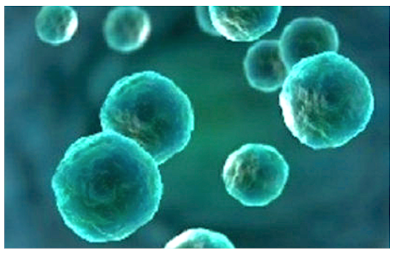 In the United States, Cyclospora causes about 11,000 illnesses and 11 hospitalizations, but infestations of this parasite do not typically result in death. Due to the self-limiting nature of the pathogen (which causes some people to not seek medical care), difficulty in diagnosing it specifically, and other factors, the Centers for Disease Control and Prevention (CDC) estimates that there could be very broad ranges of infection, from 140 to 38,000 annual cases. In North America, outbreaks of cyclosporiasis in humans have been reported mostly from contaminated fresh food products, such as soft fruits (raspberries, blackberries, and strawberries), leafy vegetables (lettuce and mixed salad), and herbs (basil and cilantro). Soil is another possible infection source, particularly in areas with poor environmental sanitation.
In the United States, Cyclospora causes about 11,000 illnesses and 11 hospitalizations, but infestations of this parasite do not typically result in death. Due to the self-limiting nature of the pathogen (which causes some people to not seek medical care), difficulty in diagnosing it specifically, and other factors, the Centers for Disease Control and Prevention (CDC) estimates that there could be very broad ranges of infection, from 140 to 38,000 annual cases. In North America, outbreaks of cyclosporiasis in humans have been reported mostly from contaminated fresh food products, such as soft fruits (raspberries, blackberries, and strawberries), leafy vegetables (lettuce and mixed salad), and herbs (basil and cilantro). Soil is another possible infection source, particularly in areas with poor environmental sanitation.
Since Cyclospora infections tend to respond to the appropriate treatment, complications are more likely to occur in individuals who are not treated or not treated promptly. These can include disorders of malabsorption, reactive arthritis, cholecystitis (inflammation of the gallbladder), and, possibly, Guillain-Barré Syndrome.
- E. coli – See informational video
Escherichia coli (E. coli) is a gram-negative bacterium that is highly diverse; there are an enormous number of types and strains with different characteristics. Most types of E. coli occur as normal inhabitants of the intestines of animals and do not cause disease. Some, however, can cause devastating illness, such as E. coli O157:H7.
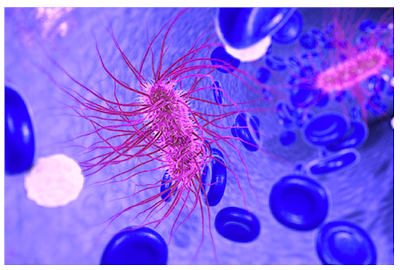 As the most notorious Shiga toxin-producing E. coli (STEC) serotype in the United States, E. coli O157:H7 is a common cause of bloody diarrhea and the most common cause of hemolytic uremic syndrome (HUS), a severe complication that involves kidney failure and is fatal in approximately 5-6% of cases. E. coli O157:H7 causes an estimated 63,153 illnesses, 2,138 hospitalizations, and 20 deaths in the United States each year due to foodborne transmission alone.
As the most notorious Shiga toxin-producing E. coli (STEC) serotype in the United States, E. coli O157:H7 is a common cause of bloody diarrhea and the most common cause of hemolytic uremic syndrome (HUS), a severe complication that involves kidney failure and is fatal in approximately 5-6% of cases. E. coli O157:H7 causes an estimated 63,153 illnesses, 2,138 hospitalizations, and 20 deaths in the United States each year due to foodborne transmission alone.
Beef is the most common vehicle of foodborne E. coli O157:H7 outbreaks, accounting for almost half of outbreaks. Most beef outbreaks are associated with ground beef, but other types of beef products have also been implicated. Leafy greens (e.g., romaine lettuce, iceberg lettuce, spinach) are the second most common cause of E. coli O157:H7 outbreaks; this has been an important and difficult food safety problem for more than two decades.
People can acquire STEC infection from food, recreational water (swimming), drinking water, contact with animals (especially cattle, goats, and sheep), and contact with a person who is or has recently been ill. Sometimes circumstances are beyond people’s control, and it is impossible to prevent becoming infected during the course of day-to-day life. However, there are certain things that can be done to reduce risk. Rinse fresh fruits and vegetables under running water without soap, bleach, or commercial produce washes. Do not wash meat, poultry, eggs, or bagged produce marked “pre-washed.” Wash your hands often, especially before, during, and after preparing food, after handling raw meat, before eating, after using the toilet, and after changing diapers or cleaning up a child who has used the toilet.
- Hepatitis A – See informational video
Viral hepatitis is a major global public health problem affecting hundreds of millions of people and is associated with significant morbidity and mortality. Five biologically unrelated hepatotropic viruses cause most of the global burden of viral hepatitis: hepatitis A virus (HAV), hepatitis B virus (HBV), hepatitis C virus (HCV), hepatitis D (delta) virus (HDV), and hepatitis E virus (HEV).
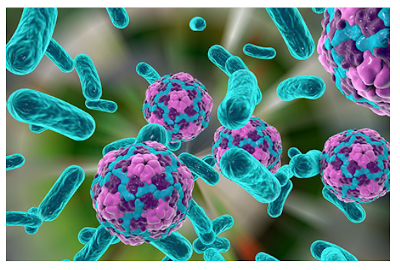 Hepatitis A is a communicable (or contagious) disease that is acquired primarily by the fecal oral route either from person to person or through contaminated food or water. Food-related outbreaks are most commonly associated with contamination of food during preparation by an HAV-infected food handler. The food handler may not recognize they are contagious or ill because the peak time of infectivity—that is, when the most virus is present in the stool of an infected individual—occurs during the two weeks before symptoms begin. The clinical manifestations and duration of illness vary a great deal, with many persons, especially young children, showing no symptoms at all. The clinical signs of HAV infection include dark urine and, sometimes, clay-colored stool, often accompanied or followed by jaundice. Associated symptoms may involve fever, abdominal pain, loss of appetite, diarrhea, nausea, vomiting, headache, and extreme fatigue. Hepatitis A is the only common vaccine-preventable foodborne disease in the United States. Each year, approximately 3,700 to 10,000 cases of hepatitis A occur in the United States.
Hepatitis A is a communicable (or contagious) disease that is acquired primarily by the fecal oral route either from person to person or through contaminated food or water. Food-related outbreaks are most commonly associated with contamination of food during preparation by an HAV-infected food handler. The food handler may not recognize they are contagious or ill because the peak time of infectivity—that is, when the most virus is present in the stool of an infected individual—occurs during the two weeks before symptoms begin. The clinical manifestations and duration of illness vary a great deal, with many persons, especially young children, showing no symptoms at all. The clinical signs of HAV infection include dark urine and, sometimes, clay-colored stool, often accompanied or followed by jaundice. Associated symptoms may involve fever, abdominal pain, loss of appetite, diarrhea, nausea, vomiting, headache, and extreme fatigue. Hepatitis A is the only common vaccine-preventable foodborne disease in the United States. Each year, approximately 3,700 to 10,000 cases of hepatitis A occur in the United States.
- Listeria – See informational video
Listeria is a gram-positive, rod-shaped bacterium that is ubiquitous and can grow under either anaerobic (without oxygen) or aerobic (with oxygen) conditions.
 Listeriosis is one of the most important bacterial infections worldwide that arises mainly from the consumption of contaminated food. The disease is caused by Listeria monocytogenes, which is considered an opportunistic pathogen that affects mainly those with underlying immune conditions, such as pregnant women, neonates, and elders, resulting in septicemia, meningitis, and/or meningoencephalitis.
Listeriosis is one of the most important bacterial infections worldwide that arises mainly from the consumption of contaminated food. The disease is caused by Listeria monocytogenes, which is considered an opportunistic pathogen that affects mainly those with underlying immune conditions, such as pregnant women, neonates, and elders, resulting in septicemia, meningitis, and/or meningoencephalitis.
Foods commonly identified as sources of Listeria infection include improperly pasteurized fluid milk, cheeses (particularly soft-ripened varieties, such as traditional Mexican cheeses, Camembert, and ricotta), ice cream, raw vegetables, fermented raw-meat sausages, raw and cooked poultry, and cooked, ready-to-eat (RTE) sliced meats—often referred to as “deli meats.” The danger posed by the risk of Listeria in RTE meats prompted the USDA to declare the bacterium an adulterant in these kinds of meat products and, as a result, to adopt a zero-tolerance policy for the presence of this deadly pathogen. The amount of time from infection to the onset of symptoms—typically referred to as the incubation period—can vary to a significant degree. According to the CDC, symptoms of Listeria infection can develop at any time from the same day of exposure to 70 days after eating contaminated food.
- Norovirus – See informational video
When someone talks about having “the stomach flu,” they are probably describing acute-onset gastroenteritis caused by one of the noroviruses.
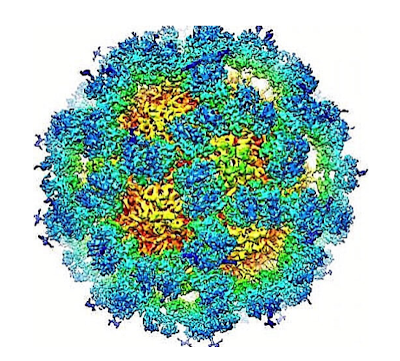 The Centers for Disease Control and Prevention (CDC) estimates that noroviruses cause nearly 21 million cases of acute gastroenteritis annually, making noroviruses the leading cause of gastroenteritis in adults in the United States. Norovirus is highly contagious and transmitted by infected individuals at an enormous rate. According to CDC estimates, this translates into about 2,500 reported norovirus outbreaks in the United States each year. Norovirus outbreaks have been reported in many settings, including healthcare facilities, restaurants and catered events, schools, and childcare centers. Cruise ships account for a small percentage (1%) of reported norovirus outbreaks overall. Norovirus outbreaks occur throughout the year but are most common from November to April. The most common symptoms are sudden onset of vomiting and watery diarrhea, although stomach cramps and pain also often occur. Some people experience fever and body aches. Symptoms usually start 12 to 48 hours after being exposed and typically last about 1 to 3 days.
The Centers for Disease Control and Prevention (CDC) estimates that noroviruses cause nearly 21 million cases of acute gastroenteritis annually, making noroviruses the leading cause of gastroenteritis in adults in the United States. Norovirus is highly contagious and transmitted by infected individuals at an enormous rate. According to CDC estimates, this translates into about 2,500 reported norovirus outbreaks in the United States each year. Norovirus outbreaks have been reported in many settings, including healthcare facilities, restaurants and catered events, schools, and childcare centers. Cruise ships account for a small percentage (1%) of reported norovirus outbreaks overall. Norovirus outbreaks occur throughout the year but are most common from November to April. The most common symptoms are sudden onset of vomiting and watery diarrhea, although stomach cramps and pain also often occur. Some people experience fever and body aches. Symptoms usually start 12 to 48 hours after being exposed and typically last about 1 to 3 days.
- Salmonella – See informational video
The term Salmonella refers to a specific group of gram-negative bacteria with the potential to cause gastrointestinal distress and other illness (i.e. salmonellosis) in humans.
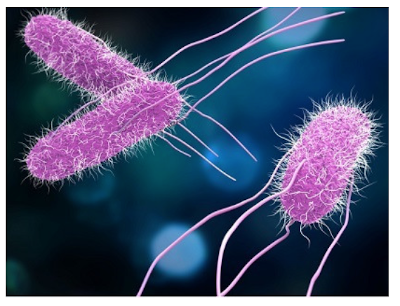 Salmonellae are widely distributed in nature and are found in the intestinal tract of wild and domesticated animals and in humans. Salmonella poisoning can occur when a person ingests contaminated fecal particles transmitted by another infected human or animal. Salmonella enterica serotypes Typhi, Sendai, and Paratyphi A, B, or C, collectively referred to as typhoidal Salmonella, cause enteric fever.
Salmonellae are widely distributed in nature and are found in the intestinal tract of wild and domesticated animals and in humans. Salmonella poisoning can occur when a person ingests contaminated fecal particles transmitted by another infected human or animal. Salmonella enterica serotypes Typhi, Sendai, and Paratyphi A, B, or C, collectively referred to as typhoidal Salmonella, cause enteric fever.
Most Salmonella infections are caused by eating contaminated food. One study found that 87% of all confirmed cases of Salmonella are foodborne. Foods of animal origin, including meat, poultry, eggs, or dairy products can become contaminated with Salmonella. Eating uncooked or inadequately cooked food—or food cross contaminated with uncooked or undercooked products—can lead to human infections. In the past two decades, consumption of produce, especially sprouts, tomatoes, fruits, leafy greens, nuts, and nut butters, has been associated with Salmonella illnesses.
Salmonella infections can have a broad range of illness, from no symptoms to severe illness. The most common clinical presentation is acute gastroenteritis. Symptoms include diarrhea and abdominal cramps, often accompanied by fever of 100°F to 102°F (38°C to 39°C), which develop after an incubation period of between 6 to 72 hours. Other symptoms may include bloody diarrhea, vomiting, headache and body aches. Reactive arthritis can develop after a Salmonella infection, as can irritable bowel syndrome and other functional gastrointestinal disorders such as constipation, heartburn, and acid reflux.
- Shigella – See informational video
Recognized worldwide as the most common cause of dysentery, the Shiga bacillus—or Shigella—is a gram-negative rod belonging to the family Enterobacteriaceae, so named because many of its members live in the intestines of humans and warm-blooded animals.
 Shigellosis is the clinical syndrome caused by Shigella species and is most typically associated with diarrhea and other gastrointestinal symptoms. Shigella species are transmitted by the fecal-oral route, and most infections are transmitted from person to person, reflecting the low infectious dose. Because of its quite common person-to-person spread, shigellosis has long been associated with outbreaks in daycare centers, nursing homes, institutional settings (e.g., prisons), and cruise ships. Shigella infections also may be acquired from eating contaminated food; studies estimate that approximately one-third of U.S. shigellosis cases annually might be caused by the consumption of contaminated food.
Shigellosis is the clinical syndrome caused by Shigella species and is most typically associated with diarrhea and other gastrointestinal symptoms. Shigella species are transmitted by the fecal-oral route, and most infections are transmitted from person to person, reflecting the low infectious dose. Because of its quite common person-to-person spread, shigellosis has long been associated with outbreaks in daycare centers, nursing homes, institutional settings (e.g., prisons), and cruise ships. Shigella infections also may be acquired from eating contaminated food; studies estimate that approximately one-third of U.S. shigellosis cases annually might be caused by the consumption of contaminated food.
Most people who are infected with Shigella develop diarrhea, fever, and stomach cramps after being exposed to the bacteria. Symptoms may start 12 to 96 hours after exposure, usually within one to three days. Reactive arthritis can develop after a Salmonella infection. The other relatively rare complication that can occur with a Shigella infection is the development of hemolytic uremic syndrome (HUS). This rare complication is more commonly caused by E. coli O157:H7, and it can lead to a low red blood cell count (hemolytic anemia), low platelet count (thrombocytopenia), and acute kidney failure. It is more common to develop HUS after being infected with S. dysenteriae.
Potential severe complications of foodborne illnesses.
- Guillain-Barré Syndrome
Guillain-Barré syndrome (GBS) is a disorder in which the body’s immune response, typically to an infection, causes nerve damage. The syndrome is rare, affecting about one to two people in 100,000 each year. It can present as a very mild case of brief weakness to devastating paralysis, affecting the muscles that allow a person to breathe on their own. Fortunately, most people eventually recover from even the most severe cases of Guillain-Barré, although some are left with some level of weakness. Guillain-Barré syndrome is not contagious.
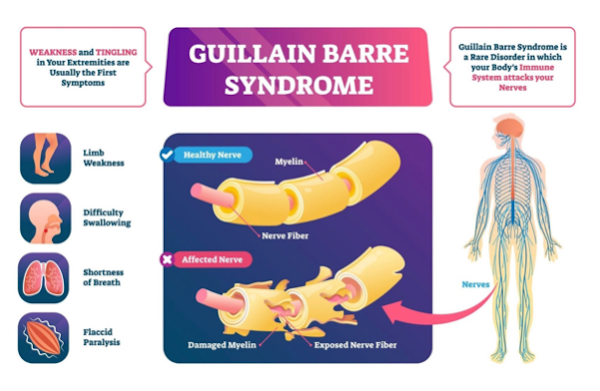
However, according to the CDC, outbreaks of associated pathogenic viruses and bacteria, including Campylobacter, can lead to clusters of people with Guillain-Barré syndrome. About one in every 1,000 reported Campylobacter illnesses leads to Guillain-Barré syndrome. As many as 40 percent of cases in the United States are thought to be triggered by Campylobacter infection.
Guillain-Barré syndrome initially causes weakness and “pins and needles” sensations that begin in the legs. These symptoms can progress up the body and become more severe, leading to paralysis of the arms and legs. There may be weakness of the face muscles, of the muscles that enable a person to swallow, or of the muscles in charge of moving the eyes. Breathing muscles may be involved, and 10-30% of patients with Guillain-Barré syndrome will need a ventilator to breathe. Blood pressure or heart rate can vary from high to low, often unexpectedly, and the patient may not be able to empty their bladder or may be constipated. Pain in the back, arms, or legs is common.
- Hemolytic Uremic Syndrome
Hemolytic uremic syndrome was first described in 1955, but it was not known to be secondary to Escherichia coli (E. coli) infections until 1983. HUS is now recognized as a cause of acute kidney failure in infants and young children. Adolescents and adults are also susceptible, as are the elderly, who often have severe disease and are at significant risk of death from the disease. The bowel inflammation that occurs prior to the onset of HUS is generally referred to as the “prodrome.”
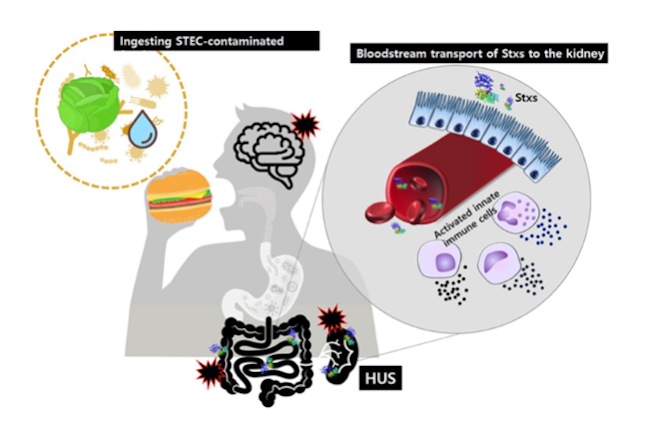
During the prodromal phase of HUS, the initial diagnosis is often acute surgical abdomen, acute appendicitis, or ulcerative colitis. After several days of diarrhea, thrombocytopenia, hemolytic anemia (secondary to the destruction of red blood cells), and acute kidney injury converge to form the trilogy that defines HUS. Physical findings on admission to the hospital may include lethargy, abdominal tenderness, blood spots or skin hemorrhages (purpura), swelling, or dehydration.
Features on admission that portend a severe or fatal outcome include coma, rectal prolapse, decreased or absent urine output, or an elevated white blood cell count (WBC)—one greater than 20 x 10^9/L (i.e. greater than 20,000 per liter). Children with HUS average about two weeks in the hospital, with a range of three days to three months. Approximately two-thirds require dialysis during the acute phase of the disease. Adults with HUS are typically in the hospital longer because their course of illness tends to be more severe.
There is no effective therapy for HUS—it cannot be stopped with medications or other therapies. Instead, treatment is supportive, which includes meticulous attention to fluid and electrolyte balance—the cornerstone of survival.
- Irritable Bowel Syndrome
Irritable bowel syndrome (IBS) is a functional disorder of the gastrointestinal tract. The hallmark symptoms of IBS are abdominal pain and altered bowel habits. Abdominal pain is usually crampy in nature, but character and sites can vary. In some patients, the pain is relieved by defecation but, in others, defecation may worsen the pain. Additional symptoms may include bloating, straining at stools, and a sense of incomplete evacuation.
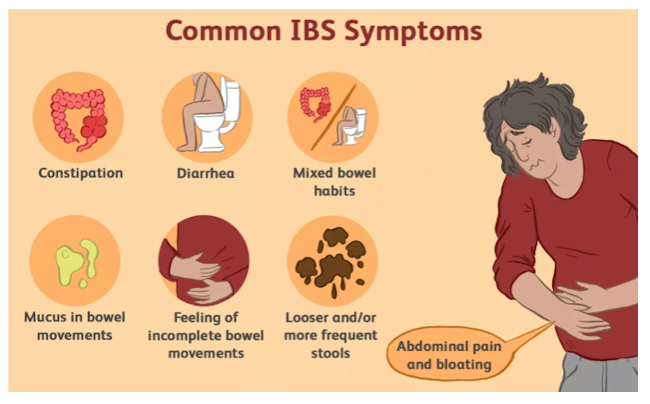
Altered bowel habits range from constipation to diarrhea, or alternating diarrhea and constipation. The symptoms of IBS may be daily but, more frequently, are episodic. Symptoms may be triggered by specific foods or by stress. Often, however, no specific triggers can be identified. It is estimated that 10-15% of the Western population has symptoms consistent with IBS, although most (75-80%) never seek medical care.
Although researchers and clinicians have not yet identified any actual anatomic changes, it is likely that some people with IBS have dysregulation in the motor function (also called “motility” or “peristalsis”) of their gastrointestinal tracts. Others develop visceral hypersensitivity, an increased sensation in response to stimuli. For example, persons with IBS will experience pain with distension of a balloon in the rectum at a smaller volume than that experienced in people without IBS. Finally, for some people, IBS affects their gut microbiome or causes intestinal inflammation, dyspepsia (i.e. indigestion), or gastroparesis (i.e. a condition in which stomach emptying is delayed, resulting in nausea, vomiting, early satiety, and weight loss).
- Reactive Arthritis
Reactive arthritis (ReA) is joint inflammation that occurs after a bacterial infection originating outside the joints (“extra-articular”). These infections are either gastrointestinal (e.g., Salmonella, Campylobacter, Yersinia, Shigella, and sometimes E. coli) or urogenital (most commonly Chlamydia trachomatis, but also Neisseria gonorrhea and Mycoplasma).
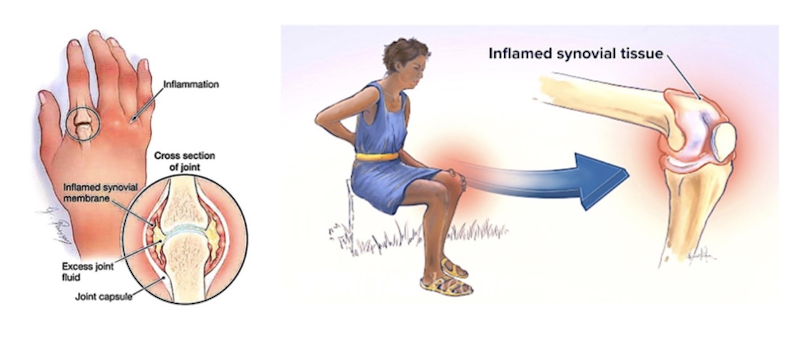
Acute ReA occurs several days or weeks after the antecedent infection. It is typically monoarticular (involving one joint) or oligoarticular (involving just a few joints, usually less than six). The lower extremities are most commonly involved, but it can also involve the arms and spine. A small subset of patients with ReA may have two additional symptoms: conjunctivitis (redness and eye pain) and urethritis (burning and pain with urination).
Typically, symptoms last for 3-5 months, and most resolve by a year. However, 15-20% may involve a more chronic persistent arthritis, with joint damage and deformity in some. Those who are HLA-B27 positive are more likely to have a worse course, as are those who have hip involvement, those who do not respond to nonsteroidal anti-inflammatory drugs (NSAIDs), and those who have elevated inflammatory markers (i.e., ESR greater than 30).
(To sign up for a free subscription to Food Safety News, click here.)

